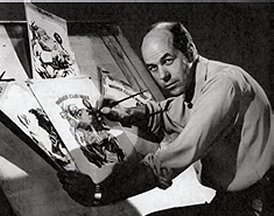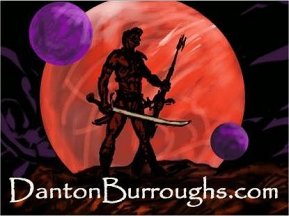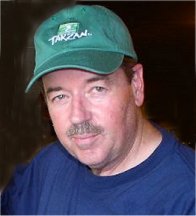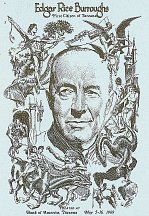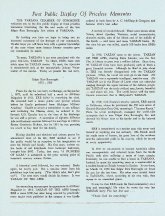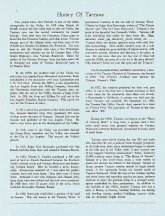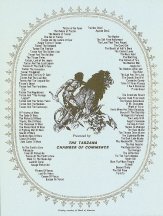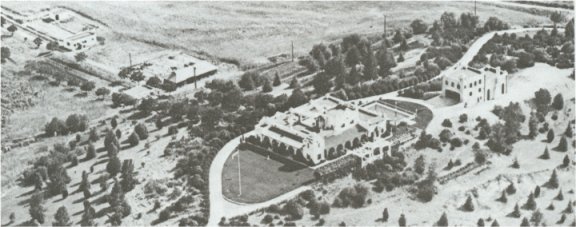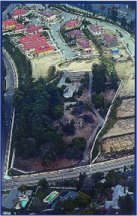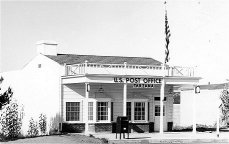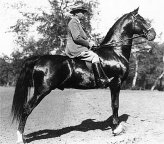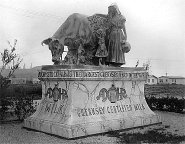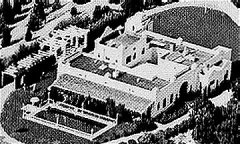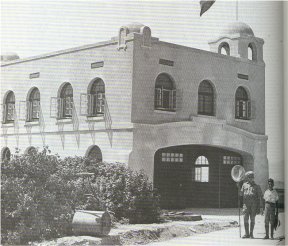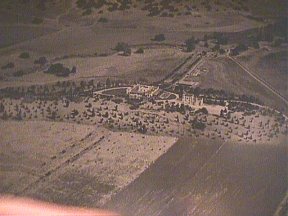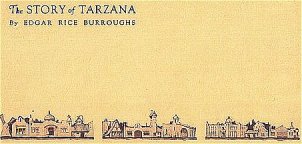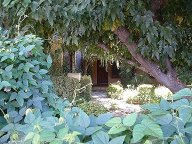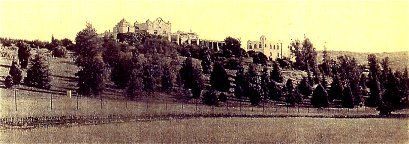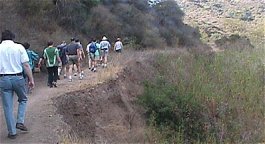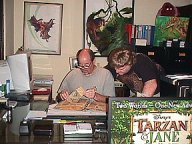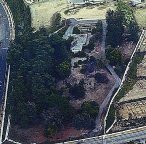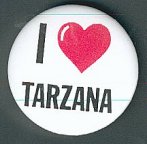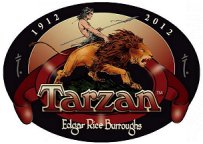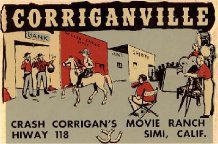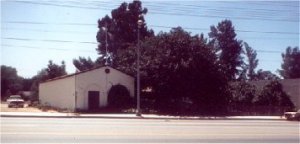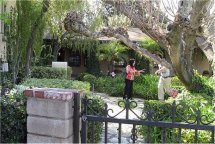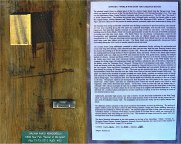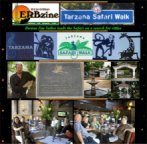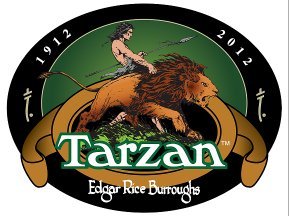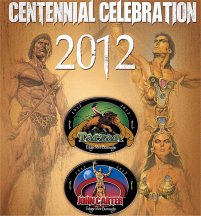Few people
know that Tarzana is one of the oldest communities in the Valley. In 1769
when Gaspar de Portola became the first white man to visit the Valley,
the Tarzana area was the second community he passed through. A
Mexican established a row crop farm on the site of the present day Las
(or Los) Encino's Historical Park, next to the still running hot spring
in or around 1789. He built the first non-Indian structure in the
Valley made from limestone from the nearby hills, which should still exist,
although heavily damaged during the 1994 Northridge Earthquake. The
structure had been returned to near original condition, except with earthquake
reinforcing and was being used as a demonstration blacksmith shop up until
the earthquake. The Mexican later became Major of Los Angeles, on or around
1800.
The Franciscan Friars
arrived in the Valley to establish the San Fernando Mission in 1797. The
Friars wanted all the land in the Valley and made a trade deal with the
Mexican on some other land East of the Valley. The Friars used his
building during the building of the Mission until there was a suitable
place to live in at the Mission. What is now Tarzana became part
of the Mission lands and later part of the 116,000 acre Rancho Ex-Mission
San Fernando. The only ones to visit the Tarzana area were a few Franciscan
missionaries and travelers on the El Camino Real (The King's Highway),
now Ventura Boulevard. Since the advent of the Ventura Freeway, there has
been some talk of changing the name of Ventura Boulevard back to El Camino
Real.
In the 1870's the southern
half of the Valley was sold to the Los Angeles Farm Homestead Association.
Main stockholders in the association were Isaac Lankershim and I.N. Van
Nuys. The initial company that Lankershim
and Van Nuys formed, purchased around 58,000 or 59,000 acres in around
1867 from as I recall De Cellis. They later sold off the difference
and retained the remaining 47,500 acres which ran roughly from present
day Roscoe Boulevard, to Mulholland Drive, from Calabasas (excluding the
El Escorpian (spelling to be corrected) Rancho, the Las Encinos Rancho
of around 4600 acres and the 2000 acres Ex-Mission lands. The original
buyers of the 10,500 or 11,500 acres that was sold off included also Gen.
Otis and others, including Charles Rindge who later with May purchased
and established the lands that formed the Malibu Ranch. Rindge was
not a later member of the Suburban Homes Syndicate.
During the 1880's,
a new organization, the Los Angeles Farm and Milling Company, succeeded
the Homestead Association, and the Tarzana area, together with the rest
of the Valley, became a huge wheat field. The
Suburban Homes Syndicate took an Option in 1909 for the 47,500 acres for
the purchase price of $2.5 million and exercised the option in the same
year. Tract 1000 was recorded in 1910.This
paved the way for the Tarzana of today.
During or around
1911, the principal members of the syndicate, being five, (there were also
thirty minority members) met to decide who would purchase which parcels.
Otis received the initial selection, or they decided to allow the head
honcho to have his pick, and purchased the 550 acres. He named it the Rancho
Del Cabrillo which is on the gate plaque and in the copper bronze plaque
that Ralph Herman discovered that ERB hid in the walls in the rear of the
garage, writing quarters and theatre -- the building where Ralph formerly
lived.
General Otis was
the publisher for, but NOT the founder of the Los Angeles Times and Mirror
Companies. Even some of the Times reporters and others continually
make this error. The Times was established around eighteen months
or longer prior to Otis putting a group together to purchase it in the
late 1880s. Otis had visited Los Angeles in around 1887 or so, then
returned maybe six months later to actually work at the Times. About a
year later, he and his group purchased it and following that, he bought
out the partners. He
took a very active part in the development of the Valley. In 1915, water
to the Valley was provided through the Owens River Aqueduct and the Valley
was annexed to the City of Los Angeles. This secured the Valley's growth.
The Adohr Dairy
land was purchased during December 1915, four years before ERB arrived,
by Marriott who had just married Rhoda Rindge. On their honeymoon, traveling
Southern California, they found the approximate 250 adjoining the Rancho
Del Cabrillo on West and roughly what is present day Lindley on the East.
Contrary to many statements often made, Adohr Farms did not extend northerly
of Ventura Boulevard.
In 1919 Edgar Rice
Burroughs purchased the Rancho Del Cabrillo and moved into the Otis home.
ERB did not build another home on the ranch until after leasing a portion
of the ranch to the original El Caballero Country Club in around 1923/24
era.
ERB starting building
the garage, writing quarters and theatre building in 1920 with the swimming
pool following along with the fish ponds now demolished.
In 1922, Charles L.
Daniels purchased a 320 acre tract of land on Reseda Boulevard from the
Southern Pacific railroad tracks as far
South as Clark Street and bordering Tarzana
Ranch. Here he founded a town, Runnymede. Runnymede consisted of one-acre
plots for poultry ranches, berry and truck farms. Soon there were 15 farms
there. There was water available for all
properties in 1922, since the Los Angeles Aqueduct was completed in November,
1913. Water hadn't been permitted for Valley use until the Valley was annexed
into the City of Los Angeles in 1915. Otis received some of the first water
with a riveted walled pipe running south to Ventura Boulevard, then down
to present day Reseda Boulevard, then southerly again on the dedication
of Reseda to the sea that General Otis initiated with the line extended
to roughly where Rosita Street intercepts Reseda Boulevard today. The Herman
family used it for many years for watering the thousands of head of sheep
we had grazing their during the summer months. It was also used by
the military during WWII.
Since there was
already a Runnymeade in Northern California, this tract became Runnymeade
II. It was never considered a "town," it was a poultry and rabbit
farm development. The intersection of Ventura Boulevard and Reseda
Avenue or possibly Street as it was then called which extended northerly
through to Northridge and perhaps another Runnymeade development, was not
known as Tarzana until after the Post Office was established.
The area prospered.
By 1928 there were 10 square miles in the town, which included Burroughs'
Tarzana Ranch.
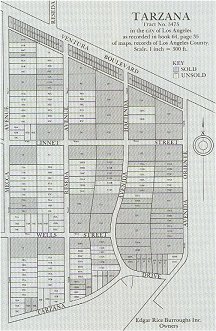 In
1923, Burroughs subdivided a portion of his land for homes. This was known
as the Tarzana Tract. A promotional brochure of the era said of Tarzana
Tract: "Chosen by Edgar Rice Burroughs, author of the Tarzan Stories
and
The Girl from Hollywood, Tarzana is the pride of the beautiful
San Fernando Valley. Tarzana will enjoy everything that makes for ideal
home life. High elevation, water, gas, electricity, paved streets, etc....
Tarzana offers you homey, spacious acres, with cool, liveable surroundings.
Here amidst nature's own, on a subdivision in which the price includes
all improvements, with convenient schools, churches and theatres, is the
place to live. Do you know that you can buy one of these full acres for
$1500, the price of a city lot in the poor district? Why hesitate? Come
out into the open and see Tarzana."
In
1923, Burroughs subdivided a portion of his land for homes. This was known
as the Tarzana Tract. A promotional brochure of the era said of Tarzana
Tract: "Chosen by Edgar Rice Burroughs, author of the Tarzan Stories
and
The Girl from Hollywood, Tarzana is the pride of the beautiful
San Fernando Valley. Tarzana will enjoy everything that makes for ideal
home life. High elevation, water, gas, electricity, paved streets, etc....
Tarzana offers you homey, spacious acres, with cool, liveable surroundings.
Here amidst nature's own, on a subdivision in which the price includes
all improvements, with convenient schools, churches and theatres, is the
place to live. Do you know that you can buy one of these full acres for
$1500, the price of a city lot in the poor district? Why hesitate? Come
out into the open and see Tarzana."
The Runnymede Poultry
and Berry Association, a forerunner of the Tarzana Chamber of Commerce,
was formed in 1923. The Women's Auxiliary later became the Tarzana Women's
Club.
In 1927, the residents
petitioned for their own post office. It was at this time that it became
necessary to find a new name for the community since there was already
a Runnymede in California. A contest was held and the name Tarzana was
accepted. On December 12, 1930, the Tarzana Post Office (fourth class)
opened in a store on Ventura Blvd. The population of Tarzana at the time
was about 300.
During the 1930s, Tarzana
was known as the "Heart of Ventura Blvd." A drug store, a grocery and a
few other small stores were grouped together on Ventura Boulevard at Reseda
Boulevard, surrounded by many acres of small farms.
Tarzana grew slowly
during the late '30s and early '40s, but after the war, a postwar boom
brought prosperity to the little town. Soon many subdivisions began to
appear in the hills and in the Valley itself. It soon became one of Los
Angeles' "bedroom communities." Today, Tarzana's 24,000 residents enjoy
living in "The Home of Tarzan." Instead of a few small shops, today a wide
variety of goods and services are offered to the shopper. Instead of farms,
modern Tarzana consists mainly of single family homes. A few apartment
houses are located north of Ventura Boulevard. While the days of the chicken
ranches and berry farms and sprawling ranches are gone, residents continue
to enjoy the gracious living ina a tranquil atmosphere established by their
predecessors. In addition to the facilities of the 1920's, modern Tarzana
now has a park, a library, a freeway, banking facilities, ice skating and
bowling centers, medical buildings, country clubs, and an extremely bright
future.



